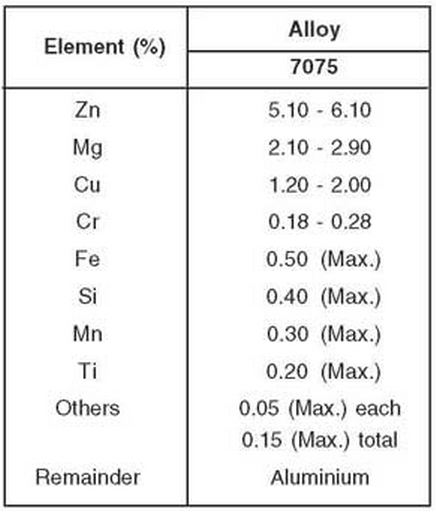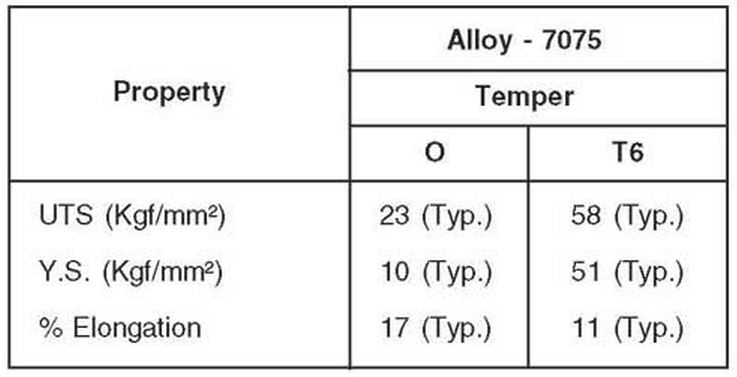





We offer the complete sheetmetal manufacturing solution, from single part or sub-assembly to turnkey solutions for mechanical and electrical assemblies. With years of manufacturing experience, we have developed an expertise that deliver the finest quality and service.
P&A has the expertise and facilities to custom manufacture a full range of transformers and toroids to your specification. We can design and deliver transformers to your requirements. Take advantage of our expertise and competitive pricing from China.
P&A offer a range of aluminium die casting services to suit clients needs predominately working with high quality aluminum enclosures and components. The fact that we are China based company enables us to deliver aluminum parts and components at most competitive pricing.
Our PCBA-based product manufacturing handles a wide range of assemblies, from single PCB assemblies to PCBAs integrated into enclosures. We support high and low PCBs for volumes and cover the entire life cycle of electronic products – from development and introduction, through to growth and maturity and end-of-life phases.
We designed and manufacture a wide variety of thermal solutions for various applications. Our products include U-type heat sinks, extruded heat sinks, cold forged heat sinks, stacked and folded fin heat sinks, heat pipes and heat pipe integrated solutions, TEC's, conduction cooling solutions and more.

The P&A Advantage
When you talk to us, you communicate with a decision makers with diverse manufacturing industry experience. That combined with excellent communication delivered by our Partners is a core of our expertise. Cost savings is just an added bonus.
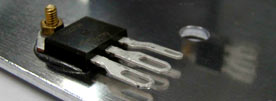
Engineering
Focusing on high-quality, custom manufacturing in China we offer professional manufacturing service of complex components and products.
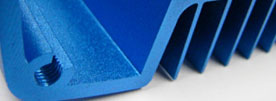
Quality Control
We focus our efforts on building strong customer relationships, which results in products in line with the market’s demands for features and quality. We find that this allow us to deliver better result that any quality assurance system can promise.
Aluminium Alloys and Production
Aluminium Uses
Aluminium is the material of choice for an array of applications from building and construction materials, consumer products, electronics and aeronautics just to name a few. You will find aluminium in safety components of your car, from the seat belt assembly to the anti-lock braking system. You will find it in other places too, your kitchen appliances, your pots and pans, your mobile phone or even in the next airplane you fly in. The applications for aluminium span almost every major industry. Its strength to weight ratio allows products to be lighter, stronger and more efficient. Its corrosion resistant properties lend itself to harsh environments, providing low maintenance solutions and ensuring extended product lifecycles. The many forms aluminium alloys can take, allow it equally to being cast into forms, drawn into tube or strand applications, extruded into intricate profiles or rolled into heavy plate or ultra-thin foils. In fact it’s hard to imagine how different our lives would be without aluminium. Read here about Applications for Aluminium Alloys and Tempers.
Production Process
Aluminium is a silver-white metal obtained from bauxite, a rock composed of more than 50% aluminium hydroxides formed by weathering in tropical regions. Aluminium is the earth’s third most abundant element (after oxygen and silicon) and the most abundant metal in the earth’s crust (8% by mass). Aluminium bearing compounds have been used by man from the earliest times. Pottery was made from clays rich in hydrated silicate of aluminium and at one point in history aluminium was so valuable that rulers and the wealthy preferred cutlery made by aluminium instead of gold. Today more aluminium is produced each year than all other nonferrous metals combined. The production of aluminium goes via two different routes: primary aluminium production from ore and recycling aluminium from process scrap and used aluminium products.
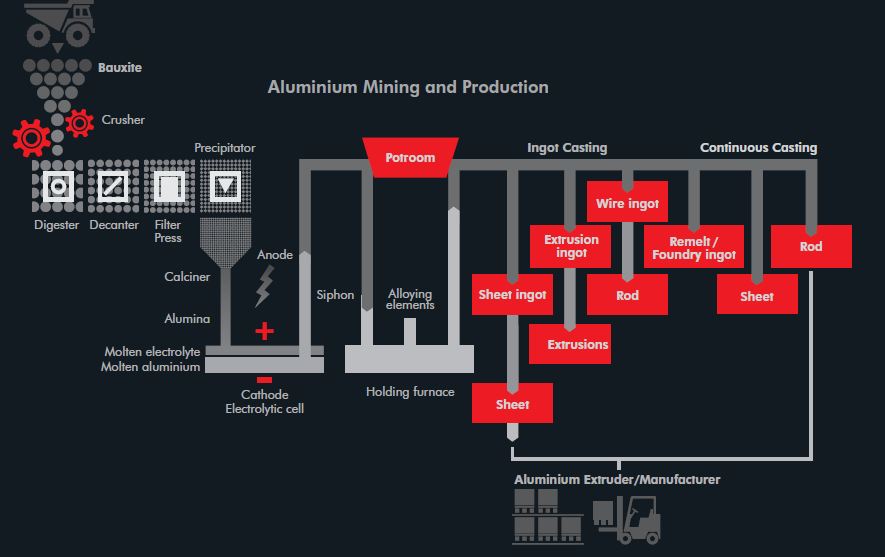
Advantages of Aluminium
A unique combination of properties makes aluminium and its alloys one of the most versatile engineering and construction materials available today.
Lightweight
Aluminium is one of the lightest available commercial metals with a density approximately one third that of steel or copper. Its high strength to weight ratio makes it particularly important to transportation industries allowing increased payloads and fuel savings. Catamaran ferries, petroleum tankers and aircraft are good examples of aluminium’s use in transport. In other fabrications, aluminium’s lightweight can reduce the need for special handling or lifting equipment.
Excellent corrosion resistance
Aluminium has excellent resistance to corrosion due to the thin layer of aluminium oxide that forms on the surface of aluminium when it is exposed to air. In many applications, aluminium can be left in the mill finished condition. Should additional protection or decorative finishes be required, then aluminium can be either anodised or painted.
Strong
Although tensile strength of pure aluminium is not high, mechanical properties can be markedly increased by the addition of alloying elements and tempering. You can choose the alloy with the most suitable characteristics for your application. Typical alloying elements are silicon, manganese, copper and magnesium.
Strong at low temperatures
Whereas steel becomes brittle at low temperatures, aluminium increases in tensile strength and retains excellent toughness.
Easy to work
Aluminium can be easily fabricated into various forms such as foil, sheets, geometric shapes, rod, tube and wire. It also displays excellent machinability and plasticity ideal for bending, cutting, spinning, roll forming, hammering, forging and drawing. Aluminium can be turned, milled or bored readily, using the correct toolage. In fact, most aluminium alloys can be machined speedily and easily. An important factor contributing to the low cost of finished aluminium parts. Aluminium is a popular choice of material for complex-sectioned hollow extrusions. Almost any method of joining is applicable - riveting, welding, brazing or soldering. A wide variety of mechanical aluminium fasteners simplifies the assembly of many products. Adhesive bonding of aluminium parts is successfully employed in many applications including aircraft components, car bodies and some building applications.
Good heat conductor
Aluminium is about three times as thermally-conductive as steel. This characteristic is important in heat-exchange applications (whether heating or cooling). Aluminium is used extensively in cooking utensils, air conditioning, industrial heat exchangers and automotive parts.
High reflectivity
Aluminium is an excellent reflector of radiant energy through the entire range of wave lengths. From ultra-violet through the visible spectrum to infra-red and heat waves, as well as electromagnetic waves such as radio and radar. Aluminium has a light reflectivity of over 80% which has led to its wide use in lighting fixtures. These reflectivity characteristics also lead to its use as an insulating material. For example, aluminium roofing reflects a high percentage of the sun’s heat, promoting a cool interior atmosphere in summer, yet insulating against heat loss in winter.
Good electrical conductor
Aluminium is one of the two common metals having electrical conductivity high enough for use as an electrical conductor. The conductivity of electrical-conductor grade (alloy 1350) is about 62% that of the International Annealed Copper Standard. However, aluminium is only a third the weight of copper, which means it conducts about twice as much electricity as copper of the same weight. Aluminium is widely utilised in power-transmission cables, transformers, busbars and bases of electrical bulbs.
Easy surface treatment
For many applications, aluminium requires no protective or decorative coating; the surface supplied is entirely adequate without further finishing. Mechanical finishes such as polishing, embossing, sand blasting, or wire brushing meet a variety of needs. Where the plain aluminium surface does not suffice, a wide variety of surface finishes are available to suit. Chemical, electrochemical and paint finishes are all used. Above all, anodising treatment can provide excellent corrosion resistance and a wide range of colour variations. Such finishes are widely used for both interior and exterior applications.
Non-magnetic
Aluminium has non-magnetic properties which make it useful for electrical shielding such as busbar or magnetic compass housings. Other applications include computer disks and parabolic antennas.
Non-toxic
The fact that aluminium is essentially non-toxic was discovered in the early days of the industry. It is this characteristic which enables the metal to be used in cooking utensils without any harmful effect on the body. Aluminium with its smooth surface is easily cleaned, promoting a hygienic environment for food processing. Aluminium foil wrapping and containers are used extensively and safely in direct contact with food products.
Others
Easy to recycle - Aluminium is void of sparking properties against itself and other non-ferrous metals.
Sound absorbing - Used for ceilings
Shock absorbing - Due to its low modulus of elasticity, aluminium is used for automobile bumpers and the like.
Non-Sparking - Aluminium is void of sparking properties against itself and other non-ferrous metals.
Aluminium Alloy 1050 (19500) chemical composition and mechanical properties.
Aluminium Alloy 1050 (1050A) is a popular grade of Aluminium. Alloy 1050 (1050A) is known for its excellent corrosion resistance, high ductility and highly reflective finish. Alloy 1050 (1050A) is typically used for chemical process plant equipment, food industry containers, pyrotechnic powder, architectural flashings, lamp reflectors, cable sheathing. When welding Aluminium alloy 1050 to itself or an alloy from the same subgroup the recommended filler wire is 1100. For welding to alloys 5083 and 5086 or alloys from the 7XXX series, the recommended wire is 5356. For other alloys use 4043 filler wire.
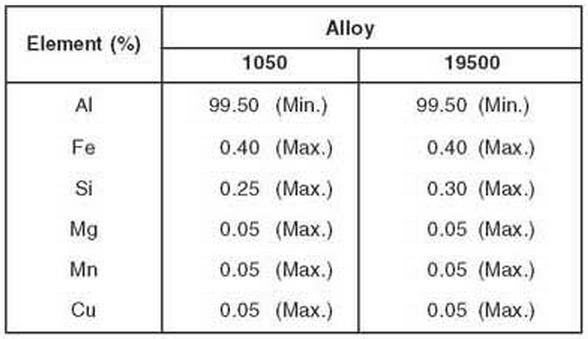

Aluminium Alloy 1060 (19600) chemical composition and mechanical properties.
This is a relatively low strength, essentially pure aluminum, alloy. It is noted for excellent welding characteristics and formability along with good corrosion resistance. It cannot be hardened by heat treatment.Commonly used in the manufacture of chemical equipment and railroad tank cars.The machinability of AL 1060 is fair to poor, especially in the soft temper conditions. In the harder (cold worked) tempers such as H16 and H18 the machining characteristics are improved. Either carbide or high-speed steel tooling may be used and use of lubricants is recommended, although some cutting may be done dry. AL 1060 may be welded by standard commercial methods. If filler rod is required it should be of AL 1060. A precaution should be noted for the use of resistance welding as by this method some trial and error experimentation may be required to obtain good results.
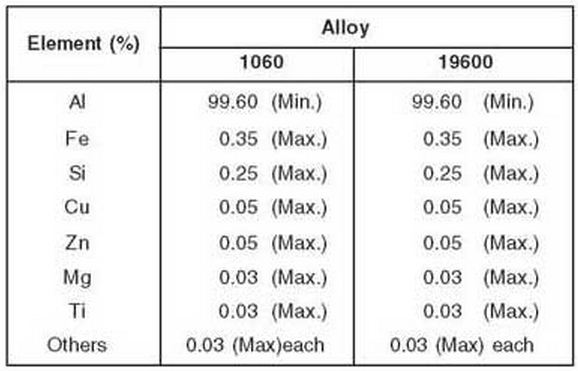
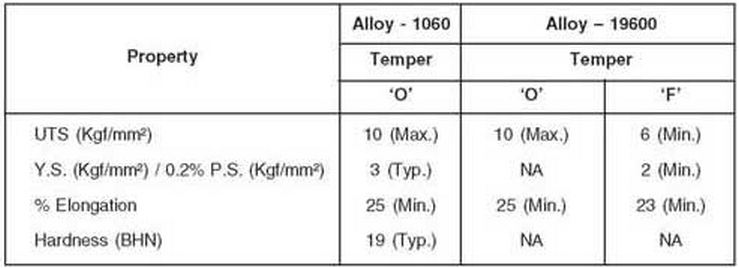
Aluminium Alloy 1070 chemical composition and mechanical properties.
Mother Tubes (Blooms) used for producing aluminium products by cold working methods such as drawing, forming
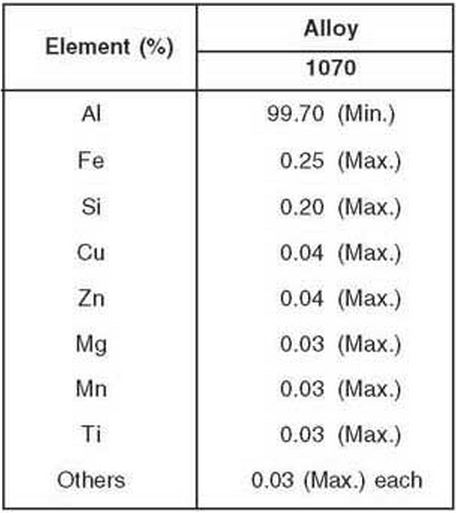
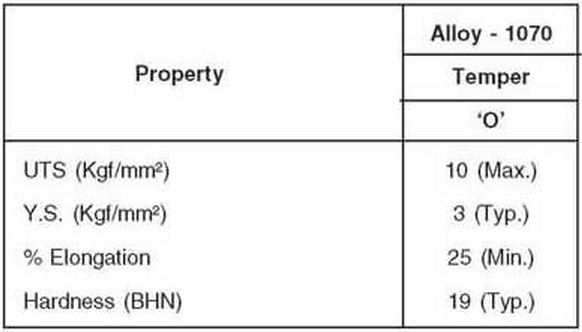
Aluminium Alloy 1100 (19000) chemical composition and mechanical properties.
This alloy is commercially pure aluminum with excellent forming characteristics.Commonly used in spun hollowware, fin stock, heat exchanger fins, dials and name plates, cooking utensils, decorative parts, giftware, rivets and reflectors, and in sheet metal work. This alloy has very good machinability. Best results are obtained when machining is done with the alloy in hard temper. Carbide tooling is preferred, but high speed steel tooling may also be used. For heavy cuts an oil lubricant should be used otherwise turning may be done dry. Forming, either hot or cold, is readily accomplished with this alloy. In the annealed condition the alloy can be cold worked extensively without an intermediate anneal.
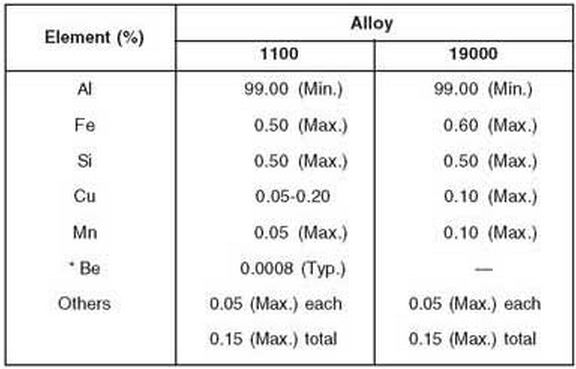

Aluminium Alloy 1350 (19501) chemical composition and mechanical properties.
Applications are Wires, Electrical Conductors, Bus Bars, Cable Sheathing, Impact Extruded Products, Transformer Strips, lugs.
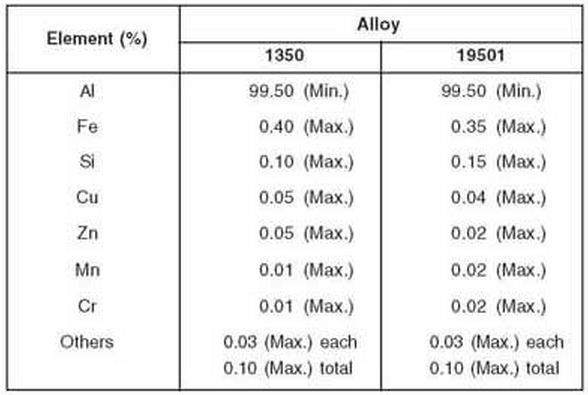
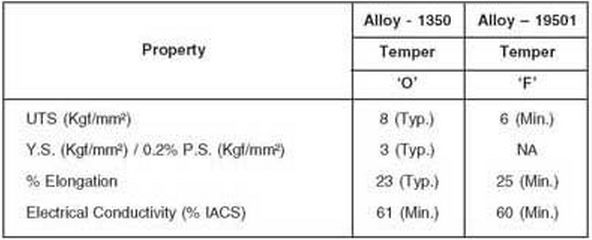
Aluminium Alloy 2011 (19501) chemical composition and mechanical properties.
Applications are Wires, Roads and Bars for Screw Machine Products, where good machinability and good strength are required.
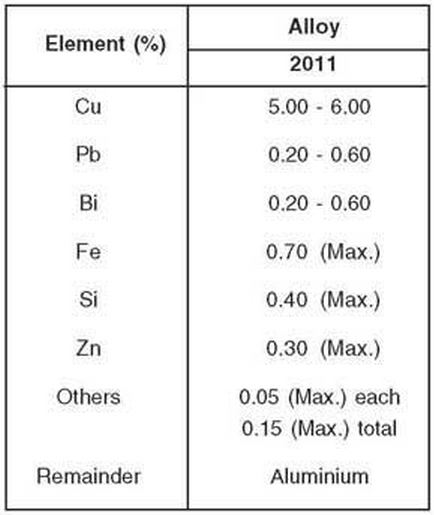
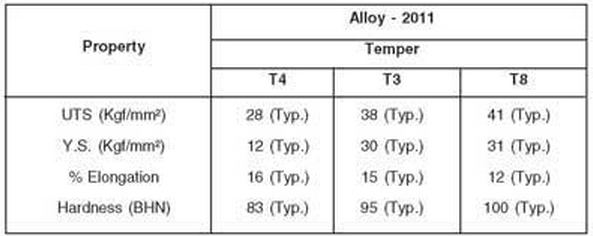
Aluminium Alloy 2014 (24345) chemical composition and mechanical properties.
Aluminium Alloy 2014 (2014 A) is a copper based alloy with very high strength together with excellent machining characteristics. Alloy 2014 is commonly used in many aerospace structural applications due to its high strength. Other applications include military vehicles, bridges, weapons manufacture and structural applications.
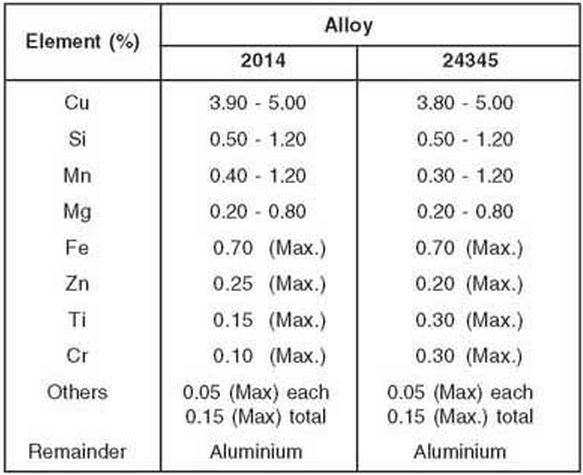
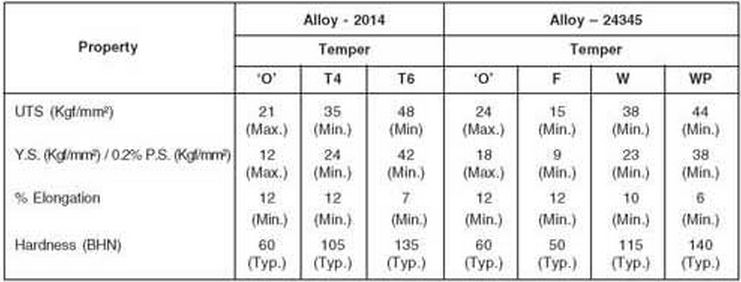
Aluminium Alloy 2017 chemical composition and mechanical properties.
Aluminium Alloy 2017 (2017 A) has high strength with excellent fatigue strength. Alloy 2017 also has very good machining characteristics. It is suitable for welding only by resistance welding. Alloy 2017 (2017 A) is used for various applications from high strength structural components, aircraft, machine construction, military equipment, rivets.
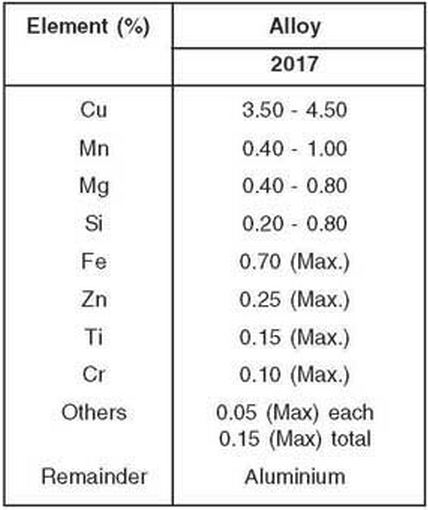

Aluminium Alloy 2024 chemical composition and mechanical properties.
Aluminium 2024 (2024A) is one of the most popular high strength Aluminium alloys. Due to its high strength and excellent fatigue resistance it is commonly used on structures and components in the aircraft and transportation industries.
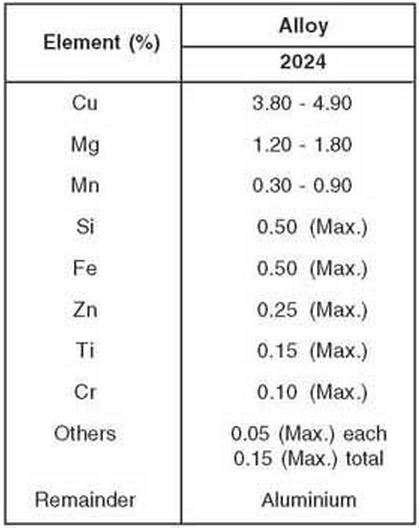
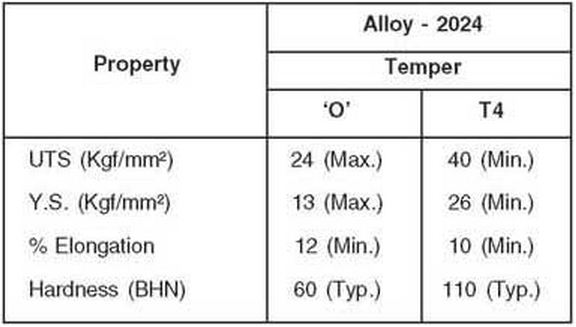
Aluminium Alloy 3003 chemical composition and mechanical properties.
This is the most widely used of all aluminum alloys including 31000. It is essentially commercially pure aluminum with the addition of manganese which increases the strength some 20% over the 1100 grade. Thus, it has all the excellent characteristics of 1100 with higher strength. It has excellent corrosion resistance. It has excellent workability and it may be deep drawn or spun, welded or brazed. It is non heat treatable. Applications: cooking utensils, decorative trim, awnings, siding, storage tanks, chemical equipment
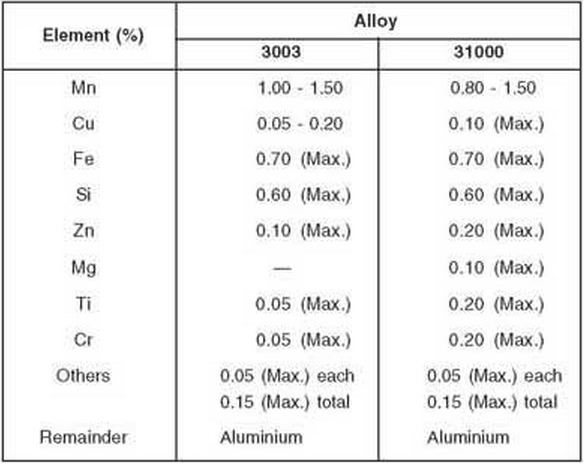

Aluminium Alloy 3103 chemical composition and mechanical properties.
Applications are Equipment for heating and cooling, heat exchangers, air condition evaporators, motor vehicle radiators, aircraft and military components, freezer linings, office equipment. Tubing, piping. Cladding alloy. Pressure vessels. Characteristic Properties: Very good resistance to atmospheric corrosion. Very good weldability. Good formability by pressing, drawing and roll forming. Medium strength alloy. Better mechanical properties (in particular at elevated temperatures) than 1xxx-alloys. Properties very close to those of 3003
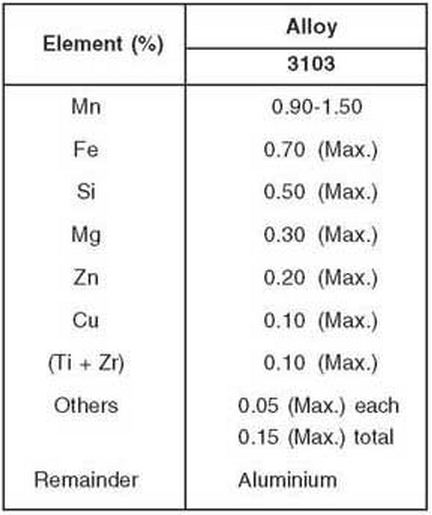
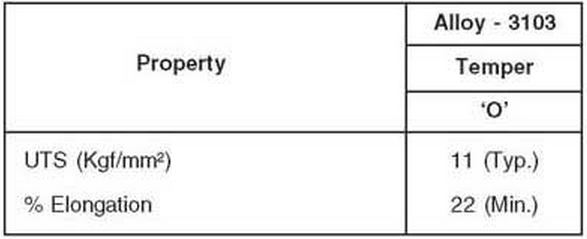
Aluminium Alloy 4043 chemical composition and mechanical properties.
Alloy 4043 is one of the oldest and most widely used welding and brazing alloys. AL4043 can be classed as a general purpose type filler alloy. Due to the addition to silicon alloy 4043 results in improved fluidity (wetting action) to make alloy 4043 the preferred choice by welders. Alloy 4043 is less sensitive to weld cracking.
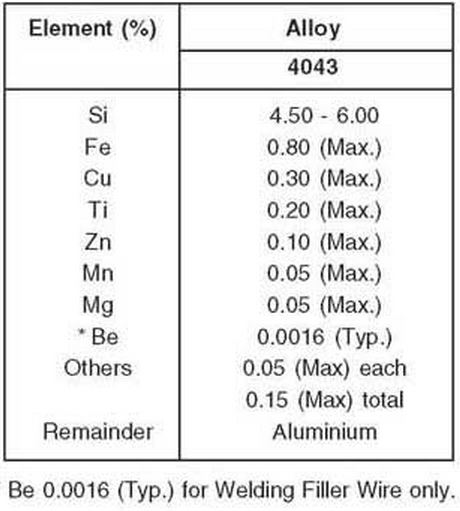
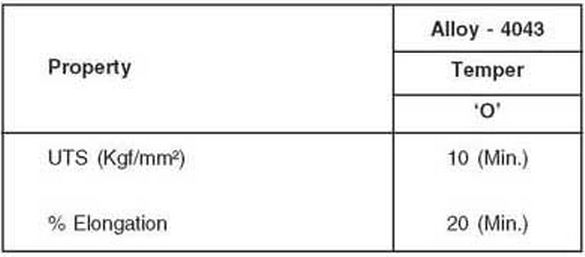
Aluminium Alloy 4047 chemical composition and mechanical properties.
Alloy 4047 is an aluminium alloy that contains 12% Silicon, which is used for high silicon alloys and automotive work. Alloy 4047 is typically used where good colour matching to the parent material is important. Alloy 4047 is precision layer-wound for positive uninterrupted feeding. Alloy 4047 is suitable for gas-shielded MIG welding on both semi-automated and fully-automated system. The filler alloy 4047 was originally developed as a brazing alloy (BAlSi-4) or (718) taking advantage of its low melting point and narrow freezing range (1070 to 1080 deg F). The main difference between 4043 and 4047 is the silicon content of these alloys. The 4043 filler alloys contain 4.5 to 6.0% silicon and the 4047 contain 11.0 to 13.0% silicon. The higher silicon additions in the 4047 alloy result in improved fluidity (wetting action) during the welding operation. This characteristic has proven itself to be extremely desirable when welding thinner materials that are required to have leak-tight joints. Welding procedures used in the heat exchanger fabrication industry have been improved by changing from 4043 to 4047 filler alloy. The 4047 provides exceptional fluidity, which helps to reduce weld leakage rates during the manufacturing process, thereby substantially improving productivity. Additional benefits from the 4047 filler alloy over the 4043 are minimizing solidification cracking and slightly higher fillet weld shear strength. Other advantages have been found in moving from 4043 to 4047. One such advantage is improved cosmetic appearance, particularly when welding thin material. The improved fluidity from the additional silicon within the 4047 filler alloy can produce exceptionally smooth welds that are cosmetically pleasing. In terms of the AWS D1.2 Structural Welding Code for Aluminum, 4047 is acceptable as a replacement for 4043 as both of these filler alloys have the same “F” number (F23). The 4047 filler alloy like the 4043 is suitable for elevated temperature service. However, the same problem with 4047 as 4043 can occur if post weld anodizing is to be performed. Because of their silicon content, both of these alloys will typically turn dark gray after anodizing, and for this reason, they are usually not recommended for products requiring this type of post weld surface treatment.
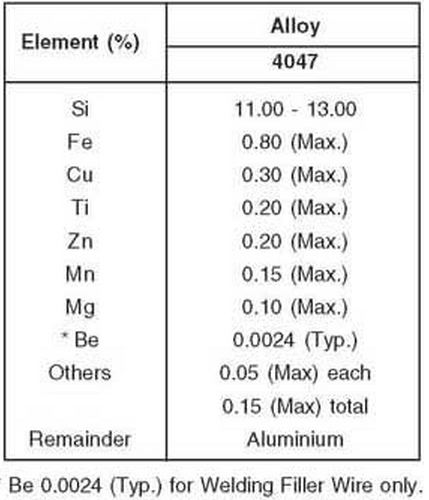
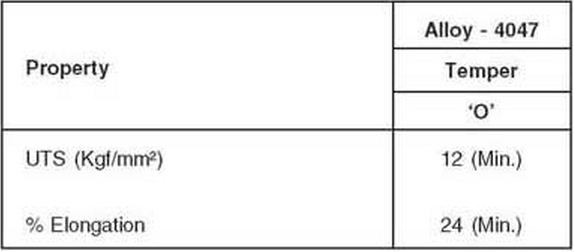
Aluminium Alloy 5052 chemical composition and mechanical properties.
Aluminium alloy 5052 in H32 temper has very good corrosion resistance to seawater and marine and industrial atmosphere. It also has very good weldability and good cold formability. It is a medium to high strength alloy with a strength slightly higher than 5251 and a medium to high fatigue strength. Commonly used in the manufacture of hydraulic tubes, kitchen cabinets, small boats, home freezers, milk crates, aircraft tube, fencing, and appliances. Commonly used in sheet metal work and in sheet metal parts.This alloy has relatively fair machinability. It is easier to machine in the hard temper than as annealed and the quality of finish is better if machined in the hard condition. Oil lubricants should be used for machining, except that very light cuts may be done dry. AL 5052 is readily formed at room temperature. Successive cold working decreases the formability.This alloy is readily welded by conventional methods. When filler rod is required it should be aluminum alloy 5356 as filler. Either tungsten or consumable electrode inert gas shielded arc welding is preferred method.
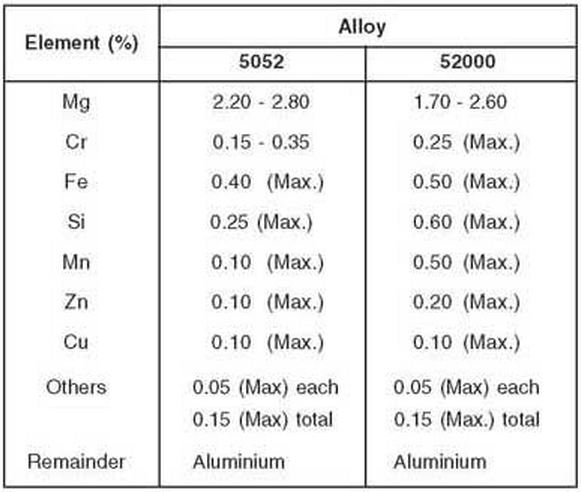

Aluminium Alloy 5083 chemical composition and mechanical properties.
Aluminium 5083 is known for exceptional performance in extreme environments. 5083 is highly resistant to attack by both seawater and industrial chemical environments. Alloy 5083 also retains exceptional strength after welding. It has the highest strength of the non-heat treatable alloys but is not recommended for use in temperatures in excess of 65°C. This is a non-heat treatable alloy for strengthening. It has very good corrosion resistance, is easily welded and does have good strength. Commonly used in the manufacture of unfired, welded pressure vessels, marine, auto aircraft cryogenics, drilling rigs, TV towers, transportation equipment, and in missile components. Forging may be done in the range of 850 to 750 F. Hot forming, when sever deformation is required, may be done at 400 F or higher to 700 F. AL 5083 is readily cold worked by conventional methods. In the annealed (O temper) condition plate of 0.250 " thick can be bent on 1.5 T radius. Annealing may be done at 650 F for sufficient time for thorough heating, followed by air cooling. Electrical conductivity 28% of copper.
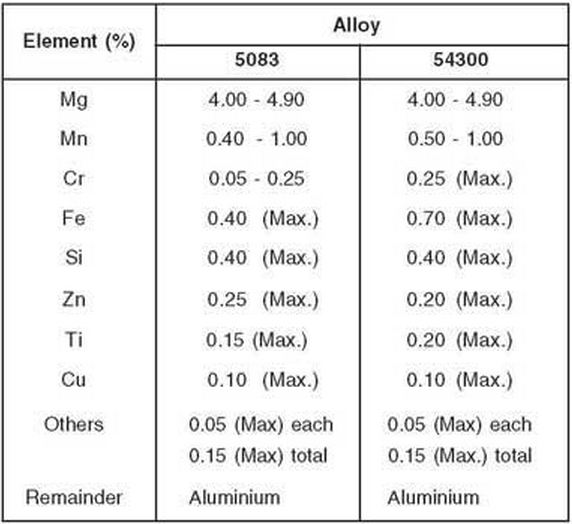

Aluminium Alloy 5086 (53000) chemical composition and mechanical properties.
This is a high strength structural alloy. It is not heat treatable.Commonly used in the manufacture of unfired, welded pressure vessels, marine, auto aircraft cryogenics, drilling rigs, tanks, TV towers, transportation equipment, and in missile components. Machining in the strain hardened tempers (H34, H36, H38) is relatively good. In the annealed (O temper) machining is difficult, but still can be accomplished. Use of lubricants is advised. Forming characteristics are best with the alloy in the O temper -- less good in the H36 or H38 tempers. This alloy is readily weldable by conventional methods. Use of electric arc welding in particular produces excellent results. The alloy is non-heat treatable. No specific data as to hot working range. However the alloy is forgeable. No data in regard to hot forming. Cold forming characteristics are excellent and usually would not necessitate hot working.Excellent cold working characteristics in the O temper and somewhat less good in H36 and H38 tempers. Anneal at 650 F for long enough to insure thorough heating. Air cooled. Electrical conductivity 30% of copper.
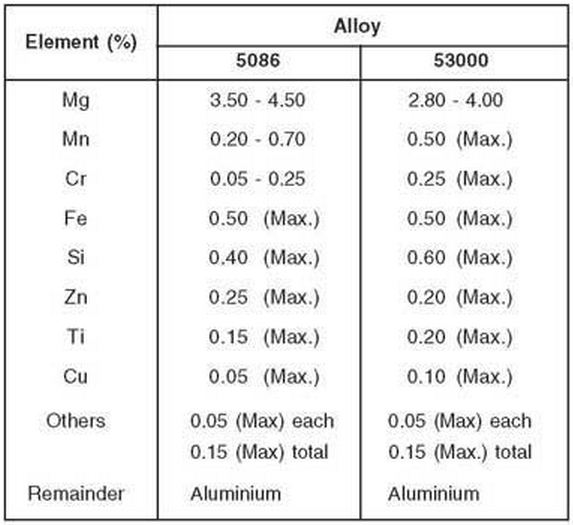
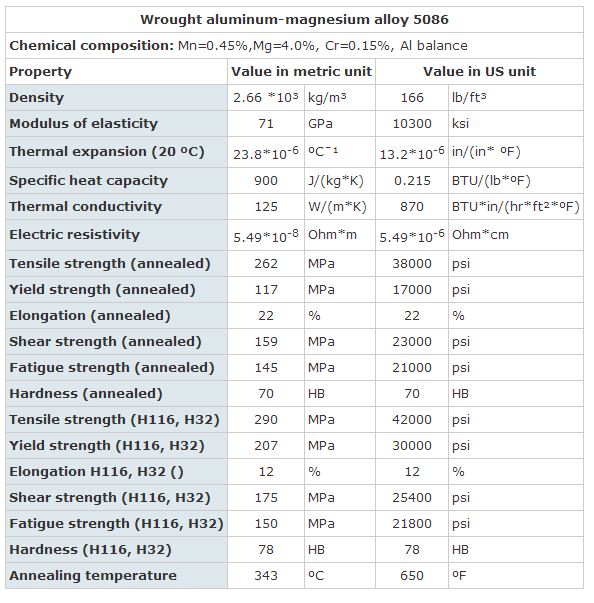
Aluminium Alloy 5356 chemical composition and mechanical properties.
5356 filler metal is the most common aluminium/magnesium alloy for general purpose welding and has high strength, ductility, toughness, fatigue and good corrosion resistance. This alloy is commonly used in the construction industry in fabricating truck trailers, small fishing boats, and in cryogenic applications. 5356 is a good choice when anodizing will be performed after welding 5xxx and 6xxx series base metal alloys. Because of the typical 5% Mg content of this alloy, the weld will have higher smut and discoloration when compared to non-magnesium bearing filler alloys. 5356 is suitable for welding 5086 strength level alloys and lower. MIG electrodes have precisely controlled wire diameter, cast and helix, high column strength and a surface condition that optimizes feedability. These features produce good commutation of electricity, reduced burn backs and produce a stable arc. The surface condition and alloy content control also produces a TIG product with excellent weldability and operator appeal. This alloy is not recommended for elevated temperature applications (above 150°F). Refer to the filler metal selection chart for further guidance in selecting filler metals for welding specific base metals.
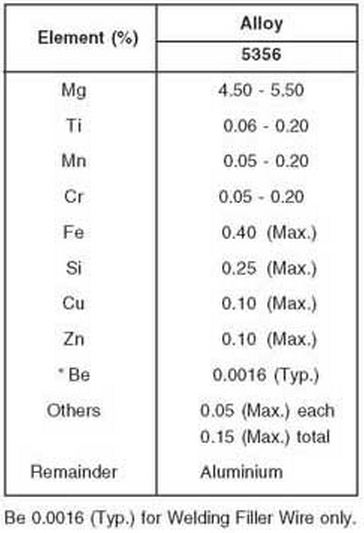
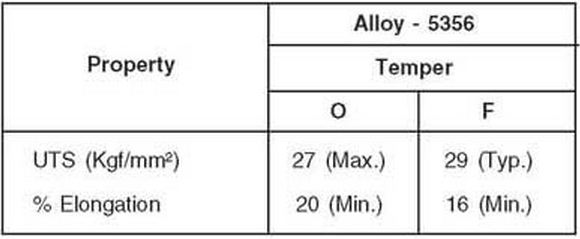
Aluminium Alloy 6005 and 6005A chemical composition and mechanical properties.
In extrusions, structural 6xxx series alloys, 6005 and 6105 are medium strength alloys that are very similar to alloy 6061 except they contain higher amounts of silicon. These alloys are used in designs that require moderate strength, but aregenerally not recommended for applications where the structure may be susceptible to impact or overloading. When bending is required, the naturally aged -T1 temper is preferred. However, due to the excess silicon content, properties may increase more rapidly with room temperature natural aging than typically experienced with 6063 and 6061alloys. In comparison to 6061, alloys 6005 and 6105 are easier to extrude and are less quench sensitive, allowing them to be used for more complex shapes. Alloys 6005 and 6105, when produced to a -T5 temper, have the same minimum tensile and yield strength as 6061-T6. In comparison to 6063, alloys 6005 and 6105 in -T5 tempers have better machinability and strength properties than 6063-T6. Alloys 6005 and 6105 can also be welded or brazed using various commercial methods (caution: direct contact with dissimilar materials can cause galvanic corrosion), although the heat from welding can reduce strength. Consult the Material Safety Data Sheet (MSDS) for proper safety and handling precautions when using 6005 and 6105 alloys. These alloys also offer good finishing characteristics and respond well to common anodizing methods such as clear, clear and color dye, and hardcoat. Datasheet for 6XXX serial alloy
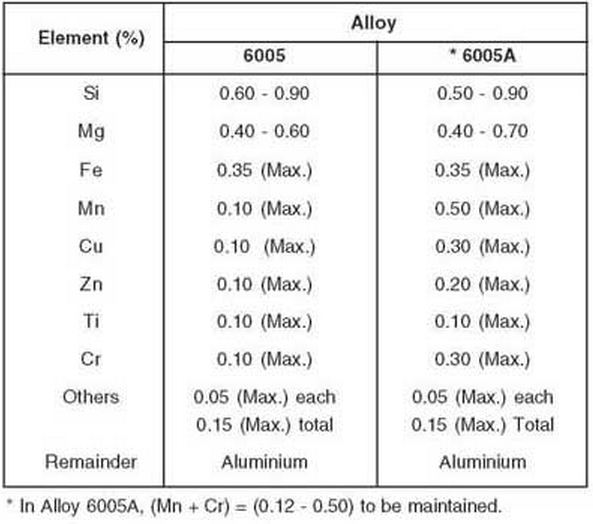

Aluminium Alloy 6060 chemical composition and mechanical properties.
Aluminium alloy 6060 is a medium strength heat treatable alloy with a strength slightly lower than 6005A. It has very good corrosion resistance and very good weldability plus good cold formability especially in temper T4. It is commonly used alloy for very complex cross sections and has very good anodizing response. Alloy 6060 is typically used for extrusions with complex cross sections and/or requiring anodising: Architectural sections for windows, doors, curtain walls, Interior fittings, frame systems, lighting, ladders, railings, fences, Heat sink sections, electronic modules, electro motor housings, Truck and trailer flooring, pneumatic installation, railway, inside applications, Irrigation, heating and cooling pipes, Furniture, office equipment.
Preheating: Billet should be preheated to a temperature in the region of 450C to ensure good extrudability and mechanical properties. Difficult sections, such as thin walled extrusions or hollows may require higher billet preheat (~470C), while simple sections may be extruded with lower preheat temperatures (~430C).
Extrusion Conditions: The temperature of the container should be set at least 30°C below the billet temperature to ensure that the billet skin is retained in the butt. The billet preheat temperature and extrusion speed should be controlled so that the exit temperature is maintained in the range of 500°C to 550°C. Typical extrusion speeds for this alloy are in the range of 40 to 100 m/min for solid profiles and 30 to 60 m/min for hollow profiles.
Press Quenching: The cooling rate of the extrudate from exit temperature down to 250C should be in excess of 50C/min to achieve minimum mechanical properties. For thin sections (less than 6mm), a still air or light fan air quench is normally adequate to achieve this cooling rate. For thicker sections (6 to 10mm), vigorous fan cooling is required to achieve the minimum cooling rate.
Straightening: Stretching to an elongation of 0.5% is recommended for straightening while stretching beyond 1% may result in orange peel finish on the extrudate.
Ageing Treatment: Various ageing times and temperatures can be used to obtain good mechanical properties. However the ageing conditions generally recommended for 6060 alloys for production operations are 6 hours at 185 +/- 5C
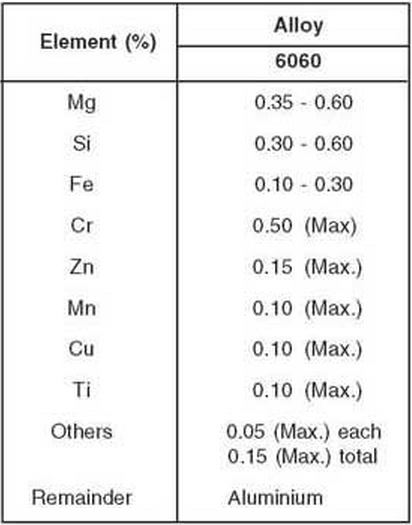
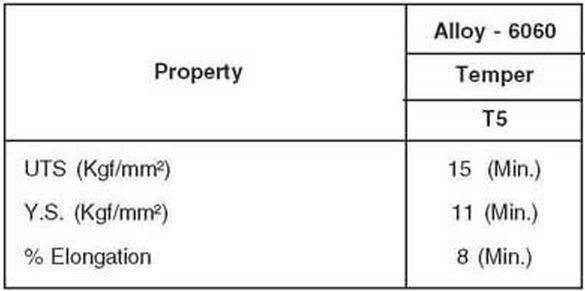
Aluminium Alloy 6061 and 65032, chemical composition and mechanical properties.
Aluminium alloy 6061 probably the most commonly available, heat treatable aluminum alloy. Commonly used in the manufacture of heavy-duty structures requiring good corrosion resistance, truck and marine components, railroad cars, furniture, tank fittings, general structural and high pressure applications, wire products, and in pipelines. Machinability in the harder T 4 and T6 tempers is good. It is notably less easy to machine in the annealed temper. Easily cold worked and formed in the annealed condition. Stamping, bending, spinning, deep drawing are all readily accomplished using standard methods. The alloy has very good welding characteristics and may be welded by all of the common welding techniques. Gas tungsten arc welding is generally used for thin sections (less than 0.032") and gas metal arc welding is used for heavier sections. Use alloy 4043 filler wire for best results, although a decrease in T 6 properties will result. Solution heat treat at 990 F for adequate time to allow for thorough heating and then water quench. Precipitation hardening is done at 320 F for 18 hours and air cool, followed by 350 F for 8 hours and air cooling. 6061 alloy is capable of being hot forged at temperatures in the range of 900 F to 750 F. Hot working may be done in the temperature range of 700 F to 500 F. Cold working in the "0" temper condition is readily performed. Aluminium alloy 65032 is notably less easy to cold form in the T 4 and T 6 tempers. Annealing should be done at 775 F for 2 to 3 hours followed by controlled cooling at 50 f per hour down to 500 F, then air cool. The aging precipitation heat treatment is done at 350 F for 8 hours followed by air cooling. This produces the T6 temper. Electrical conductivity 40% of copper.
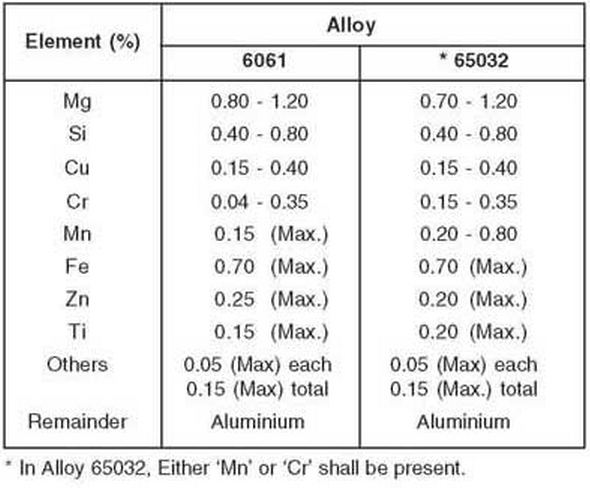
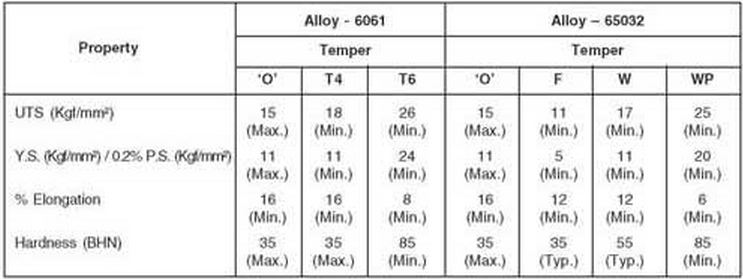
Aluminium Alloy 6063 and 63400, chemical composition and mechanical properties.
Aluminium Alloy 6063 offers excellent response for anodizing in its -T5, -T52 , -T53 (“matte finish”), -T54, -T6 (“lusterous” finish) tempers. The most common methods are clear, clear and color dying, and bright dipping and hard coat. Bright dipping provides an economical alternative to mechanical polished finishes while offering improved surface durability. Since 6063 is the alloy of choice for aesthetic applications, special packaging may be required to protect critical exposed surfaces. Alloy 6063 is not typically ink-stenciled in order to preserve its surface finish quality. If stenciling and/or special packaging is required, it should be specified at the time of quotation Alloy 6063, one of the most popular alloys in the 6000 series, provides good extrudability and a high quality surface finish. 6063 often produced for use in standard architectural shapes, custom solid shapes and heatsinks, as well as seamless and structural tube and pipe. This alloy is often used for electrical applications in the -T5, -T52 and -T6 conditions due to its good electrical conductivity. In the heat-treated condition, alloy 6063 provides good resistance to general corrosion, including resistance to stress corrosion cracking. It is easily welded or brazed by various commercial methods (caution: direct contact by dissimilar metals can cause galvanic corrosion). Since 6063 is a heat-treatable alloy, strength in its -T6 condition can be reduced in the weld region. Selection of an appropriate filler alloy will depend on the desired weld characteristics. Consult the Material Safety Data Sheet(MSDS) for proper safety and handling precautions when using alloy 6063.
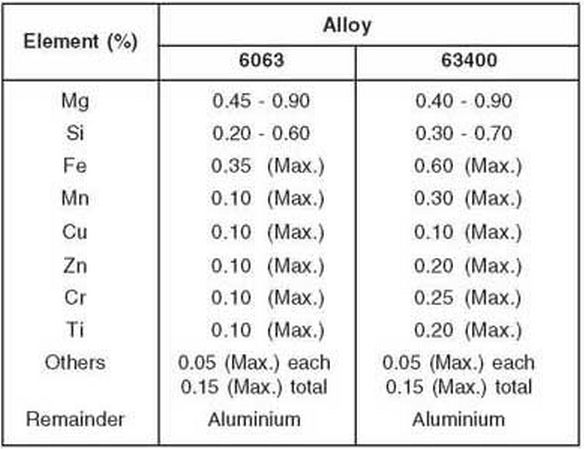
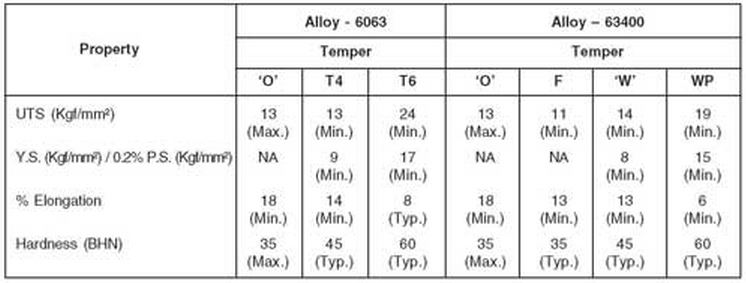
Aluminium Alloy 6066, chemical composition and mechanical properties.
Aluminium Alloy 6066 is categorized as Wrought Aluminum Alloy. It is composed of (in weight percentage) 95.7% Aluminium (Al), 1.40% Silicon (Si), 1.0% Copper (Cu), 0.8% Manganese (Mn), and 1.10% Magnesium (Mg). It can be seen in forms of extruded rod bar and wire, extruded shapes, extruded tubes, drawn tube, and forgings. Read about Influence of Heat Treatment on the Mechanical Properties of 6066 Aluminium Alloy by clicking this link.
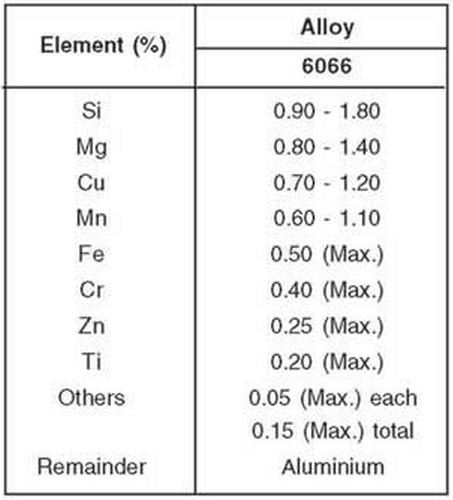
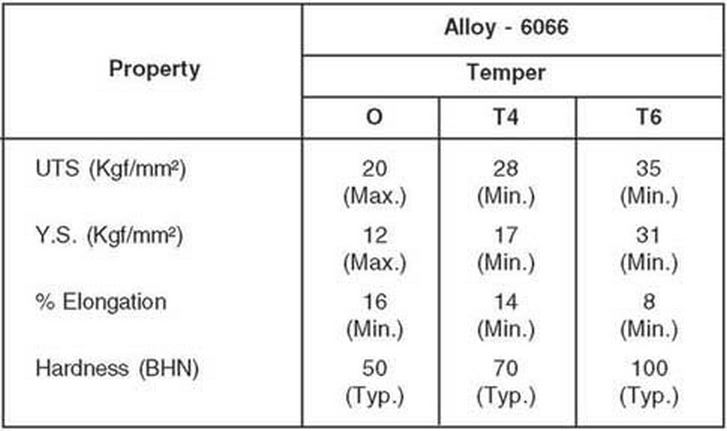
Aluminium Alloy 6082, chemical composition and mechanical properties.
Aluminium alloy 6082 is a medium strength alloy with excellent corrosion resistance. It has the highest strength of the 6000 series alloys. Alloy 6082 is known as a structural alloy. In plate form, 6082 is the alloy most commonly used for machining. As a relatively new alloy, the higher strength of 6082 has seen it replace 6061 in many applications. The addition of a large amount of manganese controls the grain structure which in turn results in a stronger alloy. It is difficult to produce thin walled, complicated extrusion shapes in alloy 6082. The extruded surface finish is not as smooth as other similar strength alloys in the 6000 series. In the T6 and T651 temper, alloy 6082 machines well and produces tight coils of swarf when chip breakers are used.
Alloy 6082 is very common in Europe and is gaining popularity in the United States for rod and bar machining stock, seamless tubing, structural profiles and custom profiles. This alloy also offers good finishing characteristics and responds well to anodizing. The most common anodizing methods include clear, clear and color dye, and hardcoat. Alloy 6082 offers good weldability, brazeability, corrosion resistance, formability and machinability. When bending or forming 6082 alloy, it is recommended to use the -0 or -T4 temper. For machining applications, 6082 provides good machinability in the -T5 or -T6 tempers. Machining chips may be difficult to break so it is recommended to use chip breakers or special machining techniques such as peck drilling to improve chip formation. For certain thin wall sections, -T6 temper may not be available due to alloy quenching limitations. Various commercial joining methods (welding, brazing, etc.) can be easily applied to 6082 alloy. However since 6082 is a heat treatable alloy, strength will be reduced in the weld region.
Intermetallic phase particles in 6082 aluminium alloy writen by International Scientific Journal.
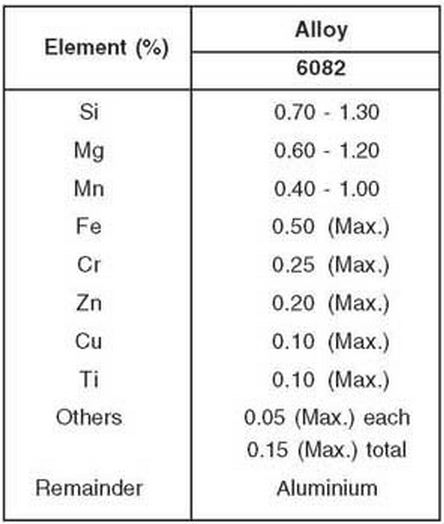
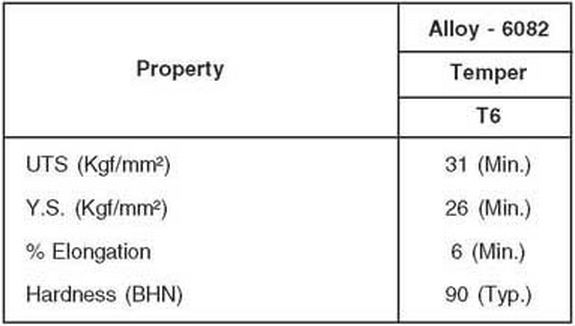
Aluminium Alloy 6101 (63401), chemical composition and mechanical properties.
Alloy 6101 is a heat treatable wrought alloy; alloy 6101 is best suited for applications involving moderate strength and maximum electrical conductivity. It is similar to alloy 6063, but with minor chemistry changes which enhance electrical conductivity. Although slightly lower in conductivity than alloy 1350, it offers greater strength. Alloy 6101 can be produced in extruded rod, bar, structural profiles, structural and seamless pipe and tube. Although this alloy is primarily used for bus conductor applications (bus bar is available with sharp corners or radius corners), it is also an excellent choice for other electrical projects. This alloy is available in various temper conditions and as a result, the purchaser does not have to worry about additional heat treating. The wide variety of tempers provide different strengths, formability, and electrical conductivity levels which allows for design flexibility. Consult the Material Safety Data Sheet (MSDS) for proper safety and handling precautions when using 6101 alloy. This alloy is easily extruded and has better machinability than our 1XXX alloy series. Alloy 6101 offers good weldability, corrosion resistance, bendability, formability, and electrical and thermal conductivity. It satisfies all ASTM B 317 specifications for a wide variety of tempers covering a broad range of mechanical properties and electrical conductivity levels.
Annealing is done at 775 F for 3 hours at temperature, followed by controlled cooling at a rate of 50 F per hour down to 500 F, then air cool. A stress relief anneal (after cold working) may be done at 650 F with air cooling. Aging is done at different temperatures and times, depending upon the finished temper desired as follows : T6 350 F for 20 hours and air cool. T61 440 F for 6 hours and air cool. T63 380 F for 19 hours and air cool. Electrical conductivity 56% of copper. Used in Electrical bus bar conductor applications for use in enclosed bus electrical installations.
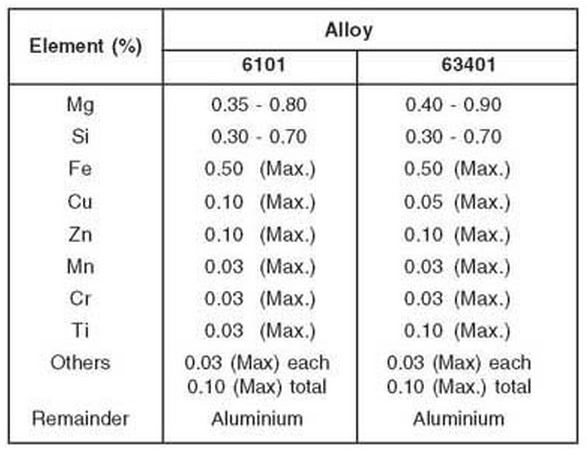
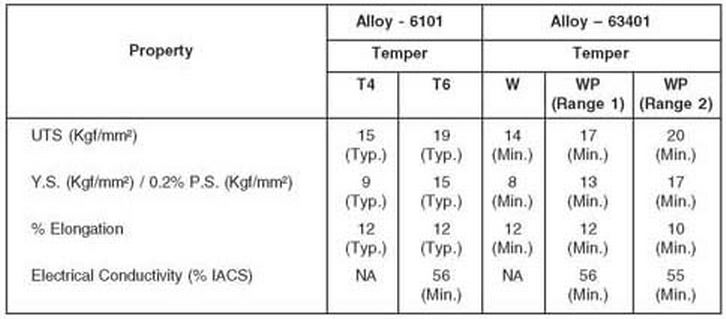
Aluminium Alloy 6201, chemical composition and mechanical properties.
Standard 6201-T81 high strength aluminium conductors, conforming to ASTM Specification B-399, are concentric-lay-stranded, similar in construction and appearance to 1350 grade aluminium conductors. Standard 6201 alloy conductors are similar to other alloy conductors commercially known as Ardival, Aldrey or Almelec. They were developed to fill the need for an economical conductor for overhead applications requiring higher strength than that obtainable with 1350 grade aluminium conductors, but without a steel core. The DC resistance at 20"C of the 6201-T81 conductors and of the standard ACSR of the same diameter are approximately the same. Conductors of the 6201 J81 alloys are harder and, therefore, have a greater resistance to abrasion than conductors of 1350-H 19 grade aluminium. Used as bare overhead conductor for primary and secondary distribution. Designed utilizing a high strength aluminium alloy to achieve a high strength-to-weight ratio; affords better sag characteristics. Aluminium alloy gives AAAC (All Aluminium Alloy Conductor) higher resistance to corrosion than ACSR.
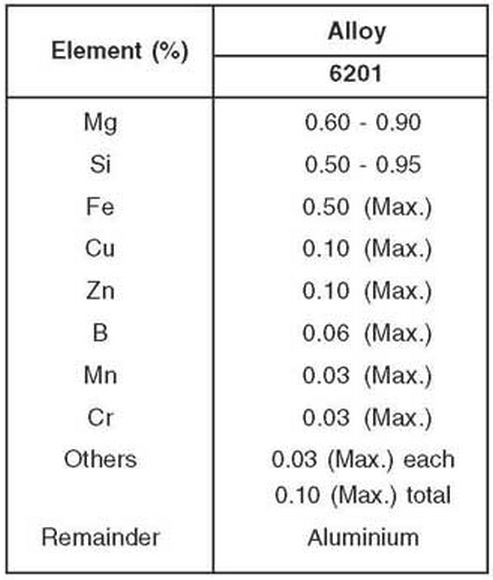
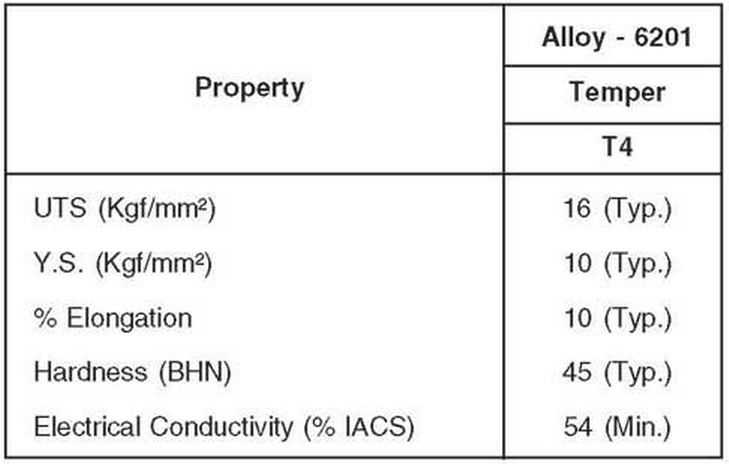
Aluminium Alloy 6351 (64430), chemical composition and mechanical properties.
This is famous alloy as it made a headlines due to aluminium scuba tanks explosions. Pressurised air tanks manufactured from AL6351 are known to develop cracks over the time and rupture violently when pressurized.
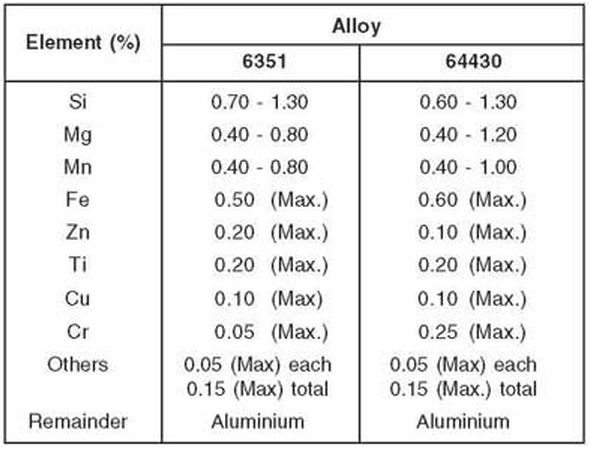
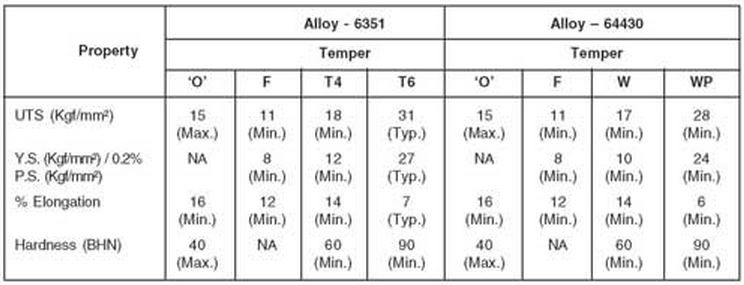
Aluminium Alloy 7039 (74530), chemical composition and mechanical properties.
Aluminium Alloy 7039 is another weldable aluminium alloy with good yield strength and fracture toughness from room temperatures down to -196°C . It is widely used as armoring to ensure maximum ballistic protection against high velocity projectiles of different type and armor-piercing ammunition. 7039 is somewhat comparable to 2090 Al-Li alloy. Modulus of Elasticity is Average Tension and Compression. In Aluminium alloys, the compressive modulus is typically 2% greater than the tensile modulus. Annealing Temperature, Stress-relief anneal; soak 2 hr, air cool to room temperature. Solution Temperature, soak 2 hr, quench in cold water; sheet stock should be quenched from 910 to 930°F, while extruded stock should be quenched from 860 to 880°F.
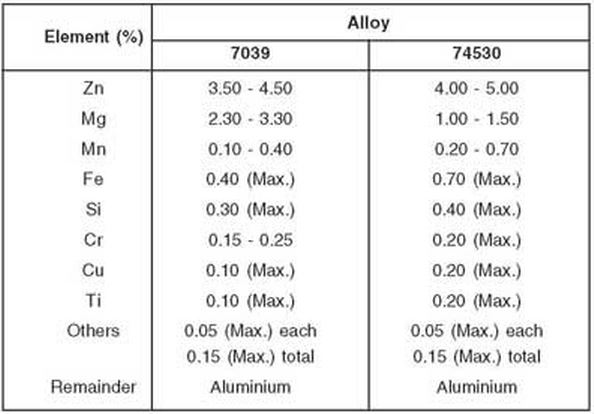
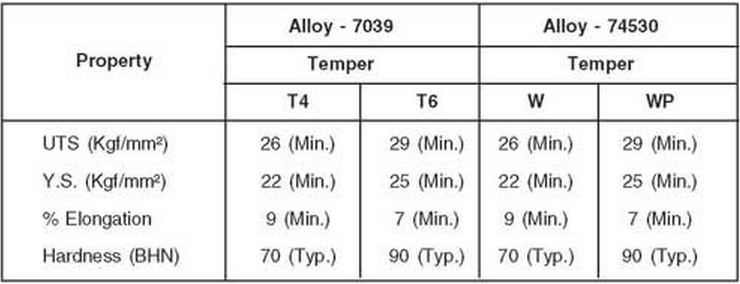
Aluminium Alloy 7075 , chemical composition and mechanical properties.
Alloy 7075, a cold finished aluminium wrought product, commonly used in the manufacture of aircraft and other aerospace applications not requiring the corrosion resistance of Clad 7075, has the highest strength of all aluminium screw machine alloys. The -T6 and -T651 tempers have a typical tensile strength of 83 ksi, which is higher than many mild steels. Due to its very high strength, alloy 7075 is used for highly stressed structural parts. Applications include aircraft fittings, gears and shafts, fuse parts, meter shafts and gears, missile parts, regulating valve parts, worm gears, keys, and various other commercial aircraft, aerospace and defense equipment. Rod and bar product forms can be machined on multi-spindle and CNC machining equipment.Alloy 7075 offers good machinability when machined using single-point or multi-spindle carbide tools on screw machines. The use of a chip breaker is recommended. The alloy is rated “B” on the Aluminium Association machinability rating system, giving curled or easily broken chips with good to excellent surface finish. Alloy 7075 has moderate corrosion resistance. The overaged -T73 and -T7351 tempers offers good stress-corrosion cracking resistance as compared to the -T6 and -T651 tempers. (Caution: direct contact by dissimilar metals can cause galvanic corrosion.) The anodizing response rating for 7075 alloy is good using commercially available methods. The alloy can be both hard and clear-coat anodized. The properties listed in this Alloy Data Sheet represent the best current information for this alloy. In each specific application, the user is expected to evaluate and test the alloy, temper and finishing method. Consult the Material Safety Data Sheet (MSDS) for proper safety and handling precautions when using alloy 7075. This alloy is comparatively strong for an aluminium alloy. As such it produces greater springback during forming operations. Forming is best done in the annealed condition and if difficulty is encountered then warming the material to 200 - 250 F will assist formability. Resistance welding is the only preferred method of joining AL 7075 alloy. Gas welding should be avoided and use of arc welding may result in degradation of corrosion resistance. The alloy may be forged in the temperature range of 900 F to 700 F. It should be solution heat treated following forging. The temperature for annealing AL 7075 alloy is 775 F, holding at temperature for 3 hours. Controlled cooling at 50 F per hour should then be used down to 500 F from which it can then be air cooled.
